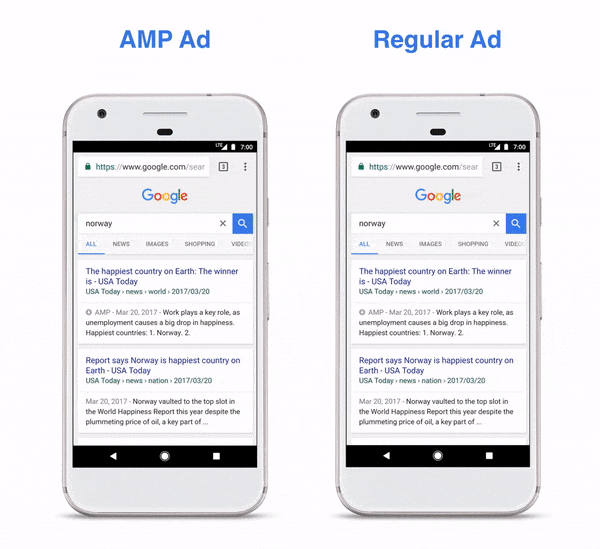The AMP (Accelerated Mobile Pages) Project is an open-source initiative by Google that makes web pages’ loading fast and user friendly. It strips down all unnecessary JavaScript and CSS to give a swift user experience. AMP improves user experience by decreasing page load time, offering Google’s CDN, and re-creating content-focused pages.
Not limited to that, a clean web page is known to offer better viewability and CTR. While it offered various UX and SEO benefits, AMP has been criticized by publishers for not offering the same revenue as their full mobile sites.
Challenges Presented By AMP
Unmatched expectations of publishers can be attributed to how AMP and advertising technologies work. Here are the reasons why AMP might not work for you:
- Removal of JavaScript: AMP is known to remove unnecessary JS and ad tags are JS code. Meaning, if you enable your webpages for AMP, many ad tags are removed and impression numbers are not the same as your expectations.
- Reporting discrepancy: With AMP pages, Google employs its CDN service for improved site rendering. This functionality sometimes inflates the pageviews, giving publishers the wrong idea of their page traffic. This leads to reporting discrepancy — pageviews and expected revenue don’t match.
- Tricky to forecast: Publishers, just like any business, rely on earning forecasts. This helps them attribute budgets for future/upcoming projects. The mentioned discrepancy in reporting makes it difficult to forecast revenue.
- Difficult to find AMP demand: Brands, in general, launch bulk campaigns and don’t put much attention to nitty-gritty like AMP inventory – they only want impressions and clicks. Since publishers face a hard time maintaining a good eCPM and CTR on AMP inventory, advertisers bounce off of and choose one with better ROI.
Your AMP Inventory is Worth More Than You Think
AMP is fast. It is the best thing that happened to the publisher’s mobile sites. In a market, where the page load time requirement is as strict as 3 seconds, mobile pages have AMP as the best option. Also, now that mobile traffic has exceeded the desktop traffic, publishers can’t stop using AMP even if it has a few cons.
Want to know more about AMP ads? Click here.
If you implement the same practices for AMP as you do for the rest of your traffic, the results might be underwhelming. Given the high viewability score of AMP pages, eCPMs are subjected to rise. But those benefits are diluted under the technological shortcomings of publishers (we will discuss those later in the article).
On the other hand, if you treat AMP like a premium inventory, then you need to understand that it only works for mobile devices. Meaning, you have to find demand partners for direct deal/in the private marketplace looking for AMP mobile inventory.
How to Make Most Out of AMP Inventory?
There are publishers who use AMP and are still able to generate good ad revenue out of it. The trick lies in the optimization and the use of the right technology.

Here are some tips:
Treat AMP inventory differently: For both direct and programmatic deals, you need to segment the AMP inventory for better targeting and tracking. Include all your demand sources to drive competition.
Take help from third-party: With the increased adoption of AMP, ad tech has improved its services to support AMP monetization. This includes header bidding with AMP, enabling AMPHTML ads, and more in the pipeline.
Run multiple tests: Enabling AMP ads is not going to work if you do not test the placements. Testing is a never-ending part of ad monetization and the same is true for AMP inventory.
Run direct-sold campaigns: If you’re unsure about enabling AMP, start by adding it to a few pages and sell it via direct-sold mobile campaigns, transparently. Measure its performance against standard inventory to establish the internal validation needed to move to the next step.
Pitch it with grace: Consider adding a separate section for AMP inventory in your media kit. Mention benefits like user experience, viewability, and better CTRs as highlights. Buyers of anonymous programmatic inventory might never see their ads on your pages — but your direct advertisers will. Focus on the quality of your audience, and advertisers should start turning in.
AMP and Ad Tech
As mentioned above, technological shortcomings stop publishers from using AMP to its complete potential. Here are those shortcomings and solutions:
AMP with Header Bidding
Header bidding is known to optimize the number of demand partners for each impression in real-time. And AMP is known to present challenges of finding the right advertiser for it. Using these two sounds like a solution.
To implement header bidding on AMP, publishers have two options:
1.) Real-Time Config (RTC), released by the AMP team in 2018 as an alternative to traditional header bidding for AMP-enabled pages.
Since RTC is a native AMP feature, there are fewer chances of errors and therefore little or no debugging involved. It has a few downsides as well. The publisher cannot have more than 5 demand partners, and while the timeout can be configured to be lower than 1 second, it cannot exceed it. Also, it lacks customizations offered by traditional header bidding.
2.) Wrapper-based header bidding, where publishers work with vendors who provide a header bidding wrapper with AMP support.
Since client-side setup has a high chance of being blocked by AMP, server-side integration works the best. Wrapper-based header bidding gets around the 5 demand partner limitation by routing bids through a single RTC slot. This means that you can add as many demand partners as you want. Wrappers will also provide publishers with reporting and analytics data, something for which RTC has no support at this time.
We at AdPushup offer wrapper-based header bidding solutions to publishers with AMP inventory.
AMPHTML support with Google Ad Manager
Google Ad Manager publishers can simply turn on the AMPHTML ad feature to make their ads AMP friendly. You can update your existing ad tags or create new ones to signal buyers (networks) that this an AMP inventory.

Sample AMPHTML ad tag:
<amp-ad width=320 height=50
type="doubleclick"
data-slot="/001122333/name_of_ad_unit">
</amp-ad>These ad tags can further be enabled with other basic features of GAM such as:
- Ad refresh: Refresh ads to leverage high engagement on AMP pages
- Sticky ad unit: Known to work best on mobile devices.
Final Word
A few publishers are dependent on search benefits offered by AMP. They want better traffic — it being the number one selling point of their inventory.
The user experience point is quite valid too — given the recent changes made to create a more transparent and user-friendly market.
But publishers don’t need to risk ad revenue for all these. The industry has evolved to offer services (such as wrapper-based header bidding) and vendors who support AMP.
The AdPushup Edge
AdPushup’s AMP Ads are designed to shoot up publisher revenue and enhance user experience.
The benefits offered by our AMP Ads include:
- Potential for increasing revenue: AdPushup’s AMP Ads support server-side header bidding contributing up to 5-25% of a website’s revenue. They are also able to tap into EBDA and AdX demand contributing to up to 30% demand. AdPushup’s AMP ads also support sticky ads, resulting in greater revenue opportunities
- Easy implementation: AMP tags can be created from the AdPushup dashboard >> AMP Ads app section
- More Reliable: As an AMP-approved RTC vendor, AdPushup brings greater reliability, resulting in stronger credibility and customer relationships
- Simplified management and multi-dimensional visuals: Performance reports can now be seen via reports by channels (s2s), ad unit formats, and by ad units
Find out more about how AdPushup’s AMP offering improves publisher revenue.

Shubham is a digital marketer with rich experience working in the advertisement technology industry. He has vast experience in the programmatic industry, driving business strategy and scaling functions including but not limited to growth and marketing, Operations, process optimization, and Sales.







